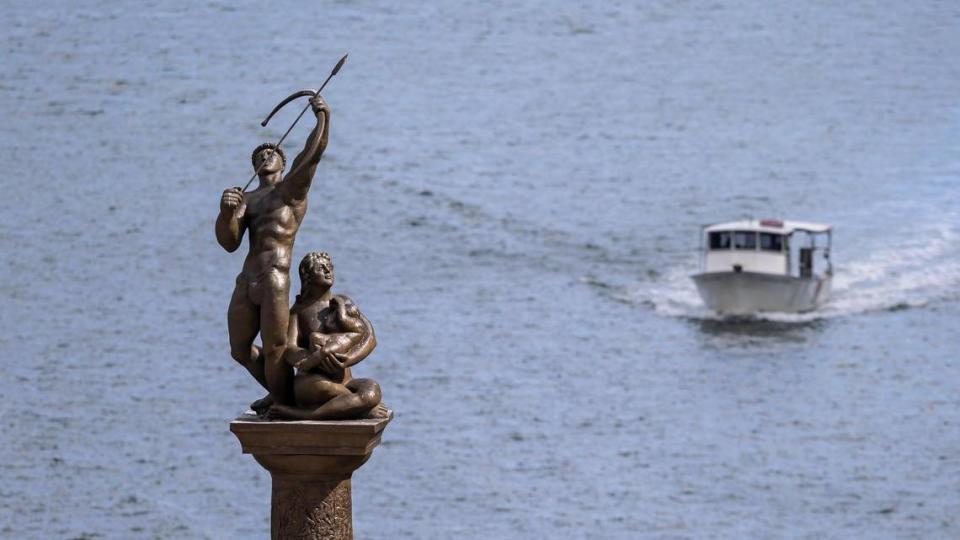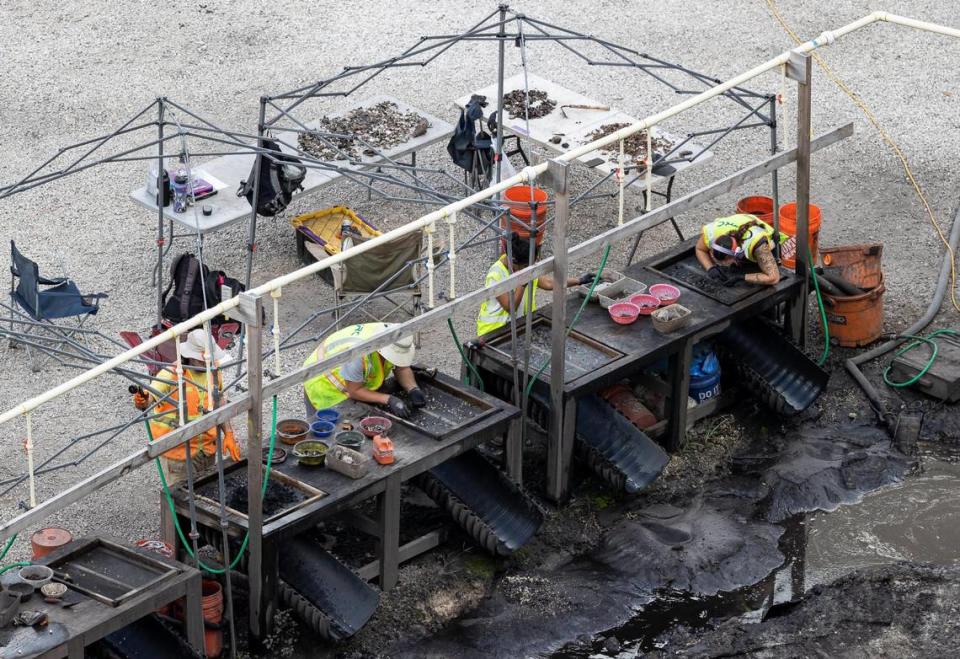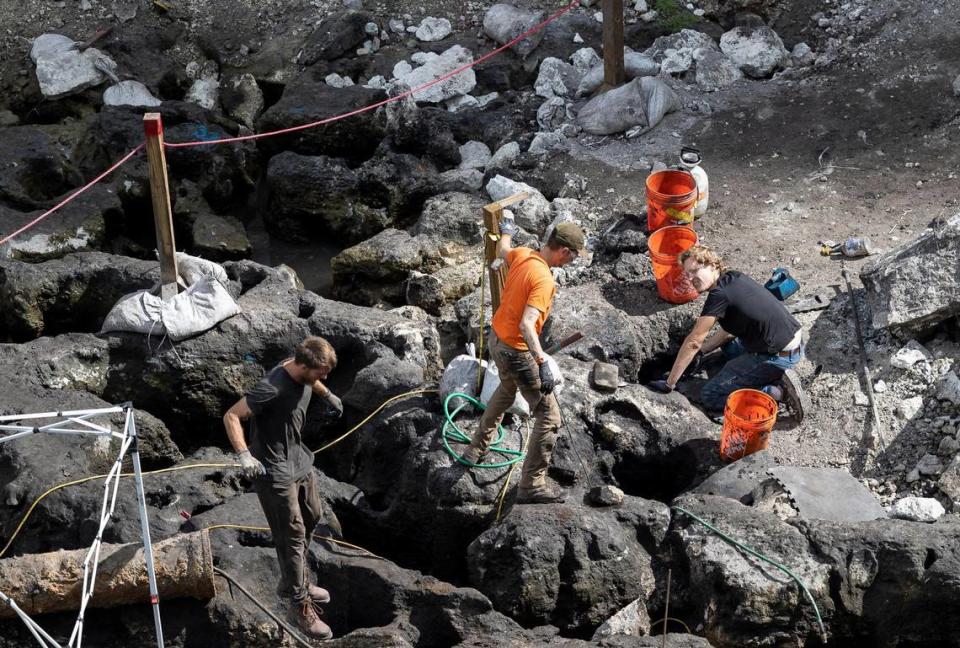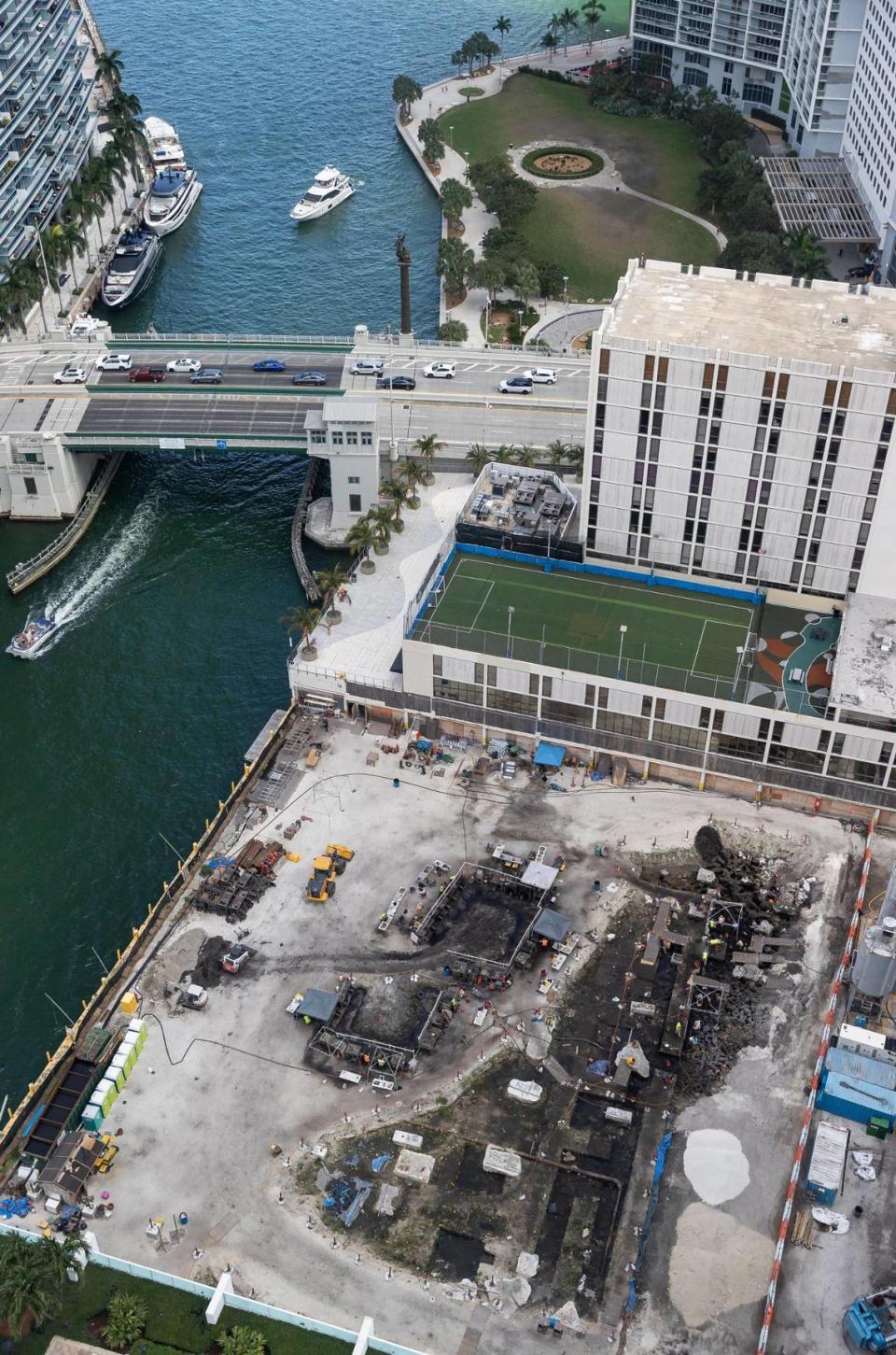The ancient discovery made on the Miami River is so significant it could derail development
The site of a major prehistoric archaeological discovery in Miami’s Brickell district is extensive and significant enough to merit protection from development under local laws, according to a new analysis jointly drawn up by independent experts and the city’s historic preservation office.
The analysis, to be presented to the city’s historic preservation board in a public hearing on Tuesday, could significantly up the ante in a growing effort by archaeologists, preservationists, Brickell residents and Native American activists to spare at least some of the ancient indigenous site, on the south bank of the Miami River, from planned high-rise development by prominent real estate developer Related Group.
A presentation slide deck prepared for the hearing concludes the site meets several of the legal criteria for designation as a protected historic and archaeological landmark, not least because of its antiquity.
The site was part of an extensive town believed to have been built some 2,500 years ago by the Tequesta tribe, which disappeared with the end of the first Spanish occupation of Florida in 1763.
Experts contend the Brickell discoveries may constitute the most significant in a series of archaeological finds made at the mouth of the Miami River in the past 25 years that include the Miami Circle National Historic Landmark, thought to be around 2,000 years old.
The independent archaeologists, including experts from the University of Miami, say a cluster of stone spear points that are among the thousands of artifacts and animal and human remains found at the site show indigenous occupation on the riverbank probably dates back as far as 7,000 years ago. (Fragmentary human remains have been removed for reburial elsewhere under supervision of the Seminole Tribe of Florida.)
Ongoing excavation of roughly half the site has so far uncovered some 350 postholes carved into the limestone bedrock that likely mark the foundation of prehistoric structures, according to the presentation.
The presentation notes that the posthole patterns include one circle, and possibly a second, reminiscent of the Miami Circle, the ancient Tequesta foundation of a ceremonial structure that’s been preserved as a state park across Brickell Avenue.

The presentation notes that the Miami Circle site and the development property were once contiguous, but were split by the construction of buildings and Brickell Avenue over decades.
The site and the trove of artifacts recovered from it represent thousands of years of previously undocumented history of indigenous settlement in Miami before modern times, and does so in an unusually rich and well-preserved fashion, the presentation concludes.
“Without seeing it for yourself, it will be difficult to imagine the enormous yield of information as material culture that has been found here,” the presentation says.
City could stop construction
If the city historic preservation board embraces the presentation’s conclusions, it could vote to launch a formal designation review that would freeze permitting and construction on most of the property until it can make a final determination on the merits, a process that can take weeks if not months.
That move could pitch a monkey wrench into longstanding plans by Related Group to build three residential skyscrapers on the site, which sits just west of the Brickell Avenue Bridge. Related, which paid $104 million for the property in 2013, has taken out a $164 million construction loan for the first phase, an apartment tower, and has begun ground preparation work for its foundations after archaeologists finished digging on that portion of the property. Related is already advertising the second planned tower, the Baccarat Residences luxury condos.
If the preservation board ultimately approves designation, it could require Related to preserve all or a portion of the site, to provide exhibition space and public access for artifacts in any project it builds, or take other measures to protect or highlight its archaeological and historical importance.
Related, founded by developer Jorge Pérez and now run day-to-day by his son Jon Paul Pérez, is expected to object to designation. The company has been largely silent on the findings and the massive excavation that’s been in progress for about a year and a half, and has consistently declined requests from Miami Herald reporters for comment or interviews. On Friday, a spokesman emailed a statement from Jon Paul Pérez, the Related president, after declining the latest request for an interview or to respond to questions from the Herald.
In the statement, Pérez said he will ask the city preservation board to delay consideration of designation until after the excavation project is completed, calling any action now “premature” and “redundant.” He did not provide a timeline.
He said the company is working on a “preservation action plan,” but provided no details. That plan would not be presented to the public until excavation is finished, a Related spokesman said.
“Related Group’s vision for the 444 Brickell site is to create a timeless and inspirational project — an investment that we knew would take time, commitment, money, and creativity,” according to the statement from Pérez. “We remain committed to delivering a property worthy of its unique location on the Miami River at the gateway to Brickell Avenue. A project that enriches the area providing public access to the waterfront and duly honoring the site’s history.
“We invested tens of millions of dollars over the last two years to ensure the archaeological integrity of the project. We contracted (and paid for) world-renowned archaeologists to painstakingly excavate and preserve all the significant findings with the utmost respect and care. And these expenses have yet to include the cost of implementing the activities laid out by our forthcoming preservation action plan.
“And we are not finished. The archaeological team continues to work on the site to ensure all findings are properly excavated, documented, and cataloged. Taking any step toward additional designations and restrictions at the upcoming HEP Board meeting is premature. The site is already protected by the strict regulations of being located within a designated archaeological area, and an overlapping designation that imposes the same procedural rules is redundant.”

Developer questioned antiquity
In an op-ed article published in the Miami Herald on March 16, Jorge Pérez cast doubt on claims of the site’s antiquity, complained of “misleading information” by critics and argued none of it is worth preserving beyond the recovered artifacts. Pérez promised in the article published on the Herald’s opinion pages, without details, that Related would store and preserve the finds and make materials available for public exhibition.
But supporters of preservation say a promise from Related is not enough. They note that developers of the Met Square project on the river’s north bank failed to fully live up to promises made in a mediation accord to preserve and exhibit another portion of the Tequesta town.
The Related site is too important to leave it up to the developers to decide what to do about it, said Abby Apé, managing director of the Brickell Homeowners Association, which supports designation. She expects several members to testify at Tuesday’s hearing in favor of requiring Related to preserve all or part of the site.
“We need the city’s leadership on this,” Apé said. “They’ve been giving the developer free rein. The city has a code. They should enforce it. Shouldn’t we have a plan in place? A lot of the neighbors are saying, do not build over it.”
Robert Rosa, a representative of the American Indian Movement and the United Confederation of Taino People who has been rallying support for preservation among Native American groups, said many tribal elders think indigenous burial sites should not be disturbed.
“We want everything returned,” Rosa said. “We want some equitable agreement. We prefer it all be preserved. We understand there is $164 million on the line. We understand that is not small chump change, but it is chump change to a billionaire. We want the desecration to stop.”
Teams of archaeologists have been quietly and painstakingly digging for at least 16 months on one of two parcels where Related plans to build. Excavation so far has taken place on the site of the demolished former U.S. Customs headquarters. A second building that houses the Capital Grille restaurant, at 444 Brickell, is still standing but would eventually be demolished and that site excavated as well.
Because the parcels sit in a city-designated archaeological zone where indigenous occupation was known to have occurred, Related was required by city ordinances to undertake and pay for archaeological exploration and excavation of the properties, being carried out under the direction of veteran South Florida archaeologist Robert Carr.
In his reports, Carr has noted the site is important enough to potentially merit inclusion in the National Register of Historic Places. He also suggests that intact sections of midden — ancient refuse heaps where many of the artifacts, bones and shells are found — could be “preserved as part of the development.”

Independent archaeologists and Miami preservation officials stress Related does appear to have met all legal requirements, including the submission to the city of reports detailing the discoveries, and preservation of artifacts and organic remnants like animal bones and shells.
Critics say city slow to act
But critics say the city did little to publicize the findings or move to consider preservation until a group of archaeologists began turning up at preservation board hearings early this year to ask that something be done. In early February, on the same day the Herald published an in-depth story describing the findings, the board voted 8-0 to order the city preservation office to begin collaborating with archaeologists from UM and the Florida Public Archaeology Network, based at the University of West Florida in Pensacola, on a fuller analysis.
The resulting presentation contains more than enough evidence to justify full consideration for designation, said one of the archaeologists, William Pestle, chairman of UM’s anthropology department.
“I would hope that the board sees fit to follow the process laid out in the city code, and not preemptively derail this before the site is given due consideration,” Pestle said.
Under that legal process, the preservation board would instruct preservation officer Anna Pernas to prepare an in-depth report and recommend whether to designate the site as historic. If designation does occur, any plans for construction or permits at the site that have not yet been approved by the city will be subject to approval by the preservation board. The preservation board would have authority to require Related to set aside open space or incorporate exhibitions and public access in its project.
Related could appeal designation to the Miami city commission, which has in the past shown itself willing to overturn historic preservation board decisions. Further appeals would go to Miami-Dade circuit court.

Site occupied for thousands of years
The new evidence, Pestle and other independent archaeologists say, suggests that the Related site was occupied by a succession of indigenous people starting in what’s known as the Archaic period, some 5,000 years before the date of the Miami Circle. Although that degree of antiquity would have to be confirmed by further analysis, Pestle and others note there is precedent for artifacts dating back that far in South Miami-Dade at the Deering Estate and elsewhere in Florida as well.
The finds also demonstrate that the Tequesta village on the river, the tribe’s principal settlement, was bigger than previously believed, they say. Spanish accounts put the settlement only on the river’s north bank. But the finds at the Related site, just steps from the Miami Circle, indicate that at its peak hundreds of years ago the Tequesta town spread along both banks of the river.
Among the most abundant finds at the Related site are postholes cut into the bedrock to support buildings and boardwalks, as well as animal bones and shells, seeds and wood, pottery shards, and stone tools used to make wooden structures and canoes. The new animal finds are likely evidence of ancient feasts and ceremonies at the site, Pestle said,
The materials, including thousands of pounds of shells and animal bones, have been carted away to storage in over 2,000 bankers boxes, Pestle said, and he expects hundreds more will be filled by the time excavation is completed.
Some critics say they think the developers and the city have attempted to downplay the discoveries to avoid the kind of public uproar and litigation that led to the preservation of the Miami Circle from condo development in 1999, as well as another Tequesta circle and other antiquities across the river at the Met Square development in 2014.


